Some of the links in this post may be affiliate links.
Othonna capensis, or the Ruby Necklace plant, is one of my favorite hanging succulents to grow indoors. It also goes by the name String of Pickles, or Little Pickles, and you can see from the photos in this post exactly how it has gotten these names!
If you are looking for an easy to grow, trailing succulent, look no further than the Ruby Necklace Plant! Keep reading to learn all about how to care for this remarkable succulent.
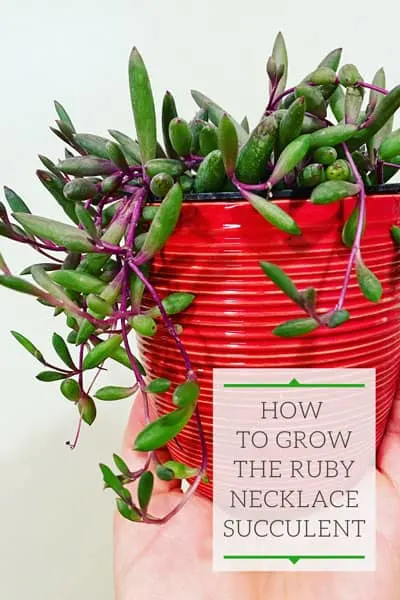
Table of Contents
Othonna Capensis Care Indoors
I’ve read some sources online that say that these plants are harder to keep indoors, but honestly, it has been just fine for me (as long as you provide the conditions that it likes)!
Ruby Necklace is a native of South Africa and is a member of the Asteraceae (or Aster) family. If you are familiar at all with Aster flowers, you will see that their flower are very typical of that plant family.
LIGHT
Othonna capensis likes to grow in full sun to partial shade outdoors. What does this translate to indoors? It means that you should provide as much light as you can indoors.
This succulent MUST be grown right in front of a window. Aim for the sunniest one that you have, and if you don’t have one, it will best be grown right under a good grow light.
Depending on the light that this plant gets, the leaves will be a different color.
In relatively lower light, the leaves will be greener. With more and more direct sun (or even under a stronger grow light), the leaves will become a deeper reddish purple color, hence the name Ruby Necklace!
When I had my own plant just a few inches below a very bright LED grow light, it was a beautiful red color. Since I moved it, the leaves are more green, but the stems maintained a beautiful purplish color.
The plant will also turn more red if it is stressed by drought or cooler temperatures (around 50F but don’t go any lower than this if you ever move your plant outdoors). It will survive lower than 50F, but is not frost tolerant.
(Just remember that cold and wet will spell death for succulents so always keep this in mind so that they don’t rot!)
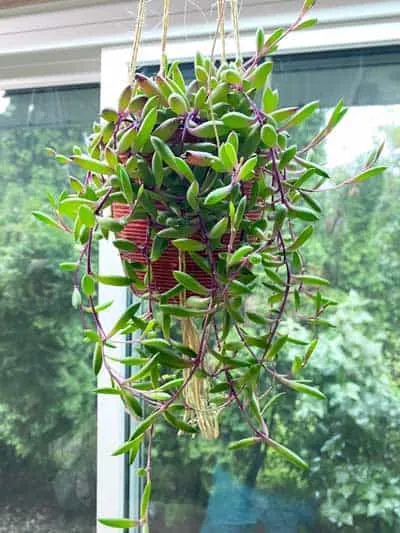
WATERING
Standard succulent watering applies!
Water thoroughly and let excess water drain away completely. Water again only when the soil has completely dried out.
SOIL
A standard soil appropriate for succulents is perfect for Ruby Necklace.
I like to mix 2 parts of a good succulent soil with 1 part of 1/4″ pumice. This creates a really sharply draining mix for your succulents. Excellent drainage is really important for the health of any succulent.
You can use perlite instead of the pumice, but I prefer pumice for succulents.
FERTILIZING
This plant is not a heavy feeder, but you should fertilize at least a couple times during the growing season.
Use a fertilizer low in Nitrogen, such as Schultz Cactus Plus.
FLOWERS
Small yellow flowers can appear throughout the year, and they look very typical of any flower in the Aster family. The daisy-like flowers will appear on long, thin stems.
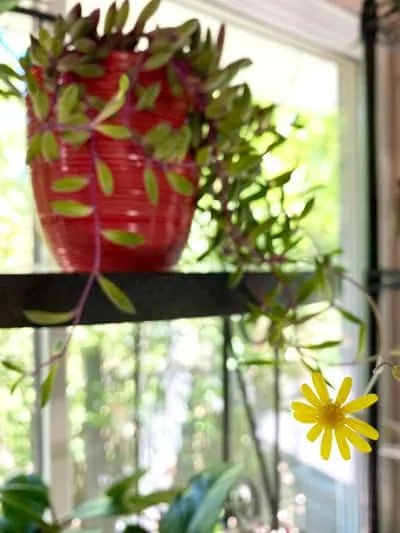
Here is what the plump flower bud looks like (look in between my fingers in the photo below) before it opens.
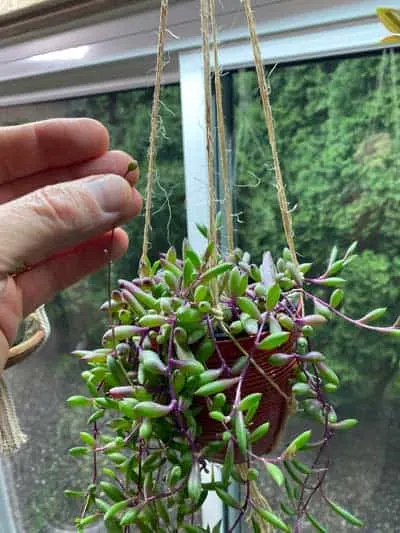
PROPAGATION
“Little Pickles” is easy to propagate. Simply take stem cuttings, let them air dry for a few days (this allows the cut to callous over and prevent rotting), and then insert the cuttings in a pot of soil.
The more cuttings you add to your pot, the better so that you can have a nice, full plant from the start.
Keep your pot in bright indirect light, but a little direct sun is OK as long as it’s not mid-day sun.
Keep the soil barely moist as the cuttings are rooting. This only applies to when you’re trying to root succulent cuttings. When you have rooted plants, you’ll want to let the soil dry out completely before soaking again.
Once the cuttings have rooted and growth has started, place the plant in the brighter light that it enjoys.

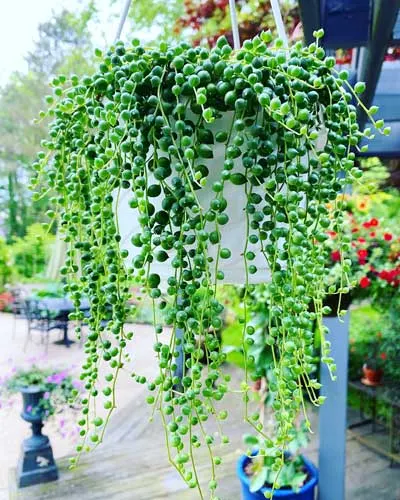
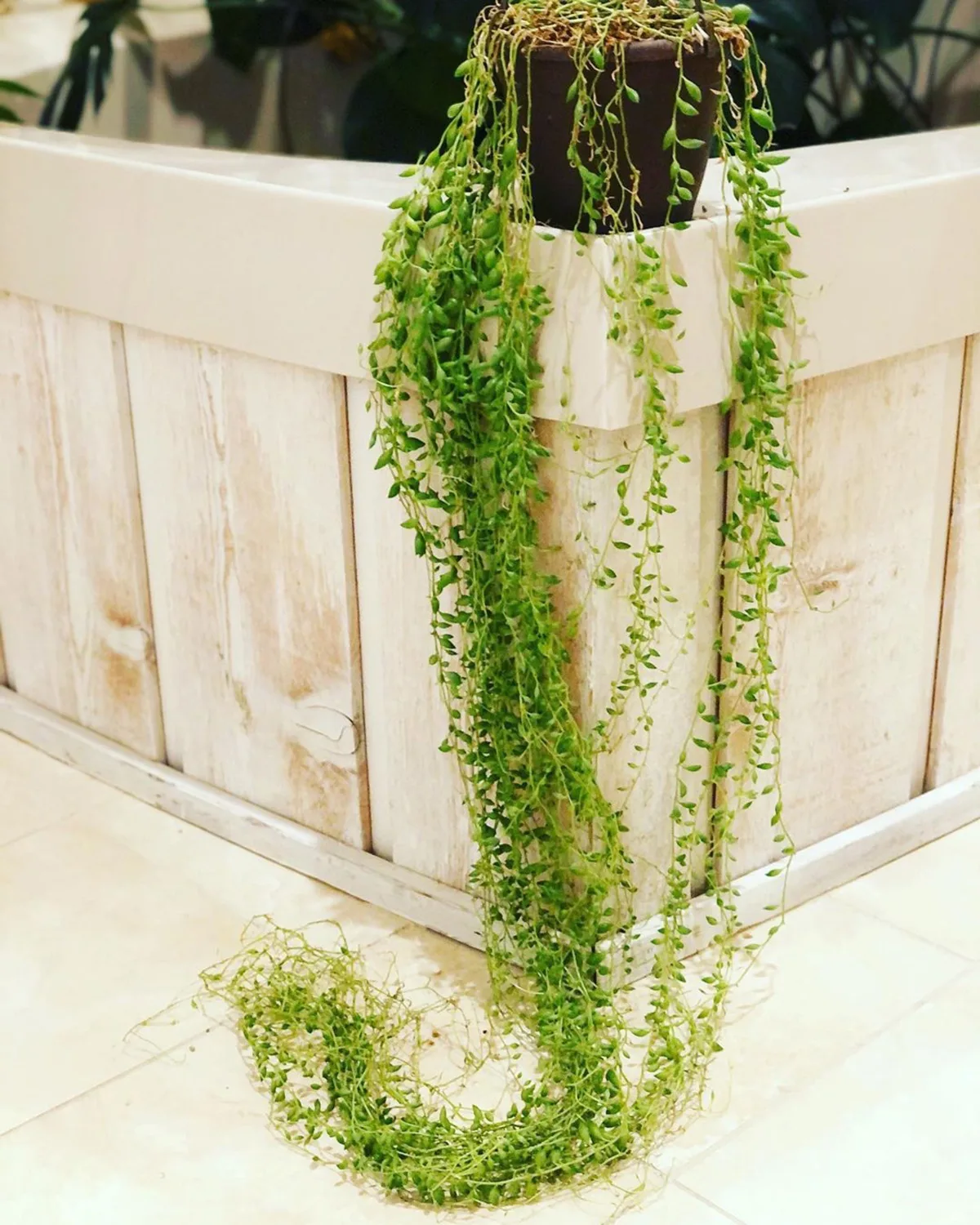
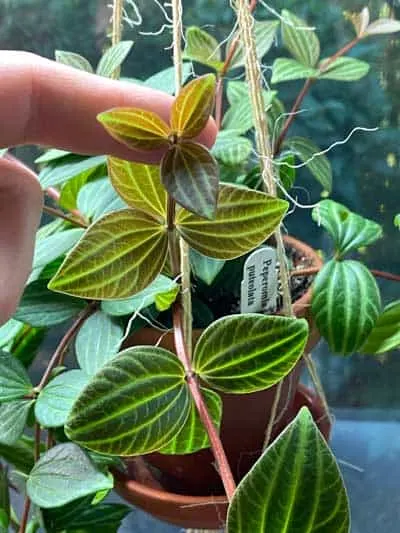
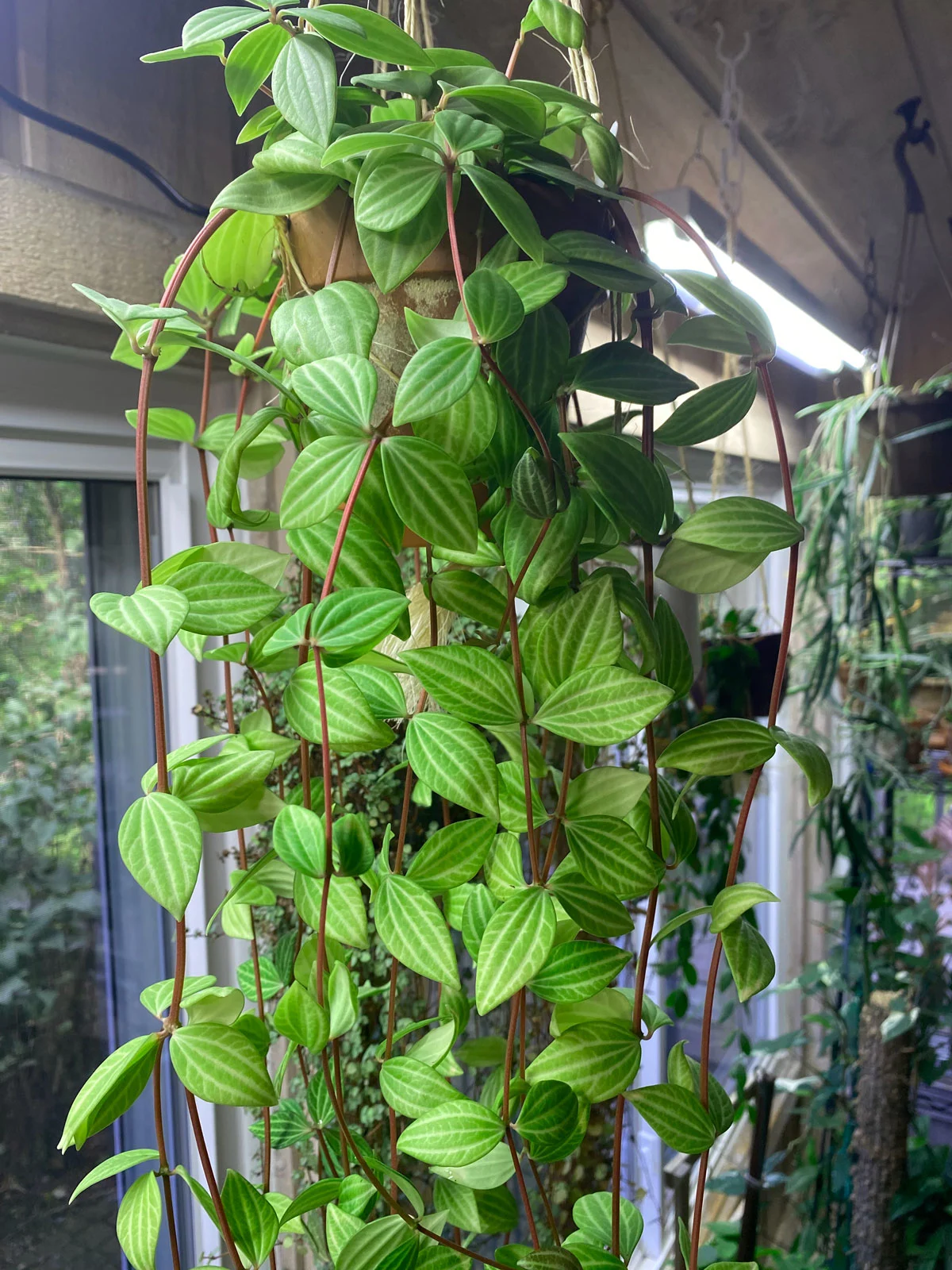
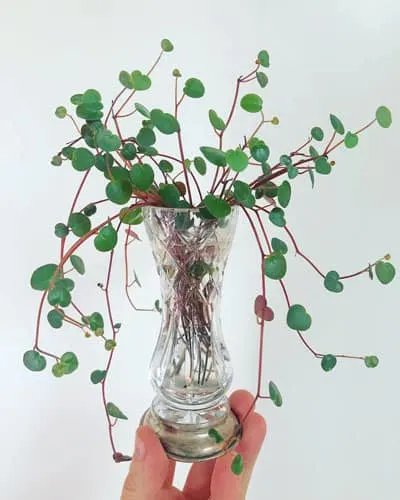
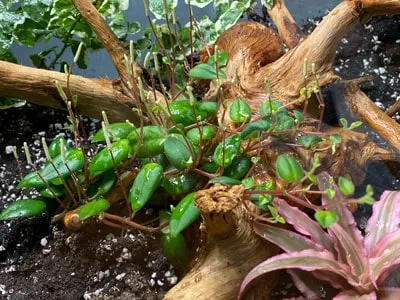
Thomas Borowski
Thursday 7th of December 2023
Plant doesn't seem to be growing, any help will be appreciated. Thank you.
Raffaele
Friday 8th of December 2023
Are you doing anything differently than what I described in the post? Do you have it in front of a very bright window?
Miss Kris
Thursday 20th of July 2023
sorry, but also, I don't know what "standard succulent watering" is- I've honestly been following the directions given by the nursery I got it from. It did really well for a few weeks, then began wilting/dying. I really appreciate any help you could offer.
Miss Kris
Sunday 23rd of July 2023
@Raffaele, thank you so much! I ordered it online, with a bundle of 10 other succulents. I had gotten a soil mixture ready beforehand: 2/3 succulent soil and 1/3 grit mix (Red Black Lava Rock, Maifanitumis, Diatomite, and Green Zeolite), which the seller had recommended. I made that soil wet, and let it dry while waiting for the plants to arrive. It was dampish when I potted the Ruby Necklace (2" pot, great roots) into a tall planter. That planter looks like a goddess; her head is the main pot, probably 4" dia and 4-5" deep. I filled the entire bottom with natural fishtank gravel for drainage, and there is a hole in the bottom. I planted the root ball in the soil mixture I made, and filled around it. For several weeks, she just kept pushing new growth- it was so cool!! :) I have been gently and lightly spraying all of them every morning- just enough to wet the inside of the succulents, and the RN.
Then the skinny end bits started wilting and drying up- so I watered it, and then all the "branches"/tendrils began drying up/dying. Now it's just a half-dead mess. I pulled it from the planter and it's just sitting on a dish of soil, until I can figure out how to save it.
Raffaele
Friday 21st of July 2023
I'd need more details to help. But you'll want to water thoroughly and let all the water drain again. Then allow the top inch or so of the soil to dry out before watering again. They can take drier soil, but don't wait too long if it has gone completely dry...And they need a few hours or more of direct sun to do their best. Hope this helps a little.
Miss Kris
Thursday 20th of July 2023
I need help! I bought one about 6 weeks ago; it arrived healthy, and immediately began growing, after I planted it in a mix of succulent soil and a pumice/succulent 3-mineral mixture. The soil is dry, the grow light is close and relatively bright, location indirect southern exposure window. I have been lightly misting, daily (all of my succulents; others aren't doing well anymore, either). It has PLENTY of drainage (gravel in 4/5 of the planter its in). But it started dying, so I gave it some water thinking I let it get too dry for too long...and now it's really dying. I honestly don't know what I'm doing wrong, and it's breaking my heart.
I wish I could show you before & now pics.
Raffaele
Friday 21st of July 2023
I just responded to your other comment. The light situation sounds good. It sounds like it's more of a watering issue. Follow the instructions that I wrote back to you on your other comment. Good luck!
Angela Jarvis
Saturday 1st of July 2023
Hi, I've had my Ruby Necklace for a few months. She was doing great, but something changed and I don't know what did. Now her tops are browning off... and the top is looking very bare. Can you give me tips and or tricks to bring her back to beauty.? I've been feeding her fertilizer once a week, but that started in the spring. It's super thrive grow 7-9-5. Thanks,
Tanya
Monday 20th of March 2023
I have mine inside with a grow light. It seems to be growing really well. However, the middle of the pot looks empty. Like it just grows out to the edges. This week I've actually had a couple of strings die on me. I'm thinking I need to repot it, but I would like to propogate as well. Should the middle of the plant be building up as well? Should I wait to propogate?
Raffaele
Monday 20th of March 2023
You can really propagate it anytime you want. Sounds like the crown of the plant thinned out somehow. It can happen if it has dried out for too long or maybe if the crown of the plant didn't have enough light for a while. You can always start new with fresh propagation. Once the base of the plant is bare, it doesn't really come back.